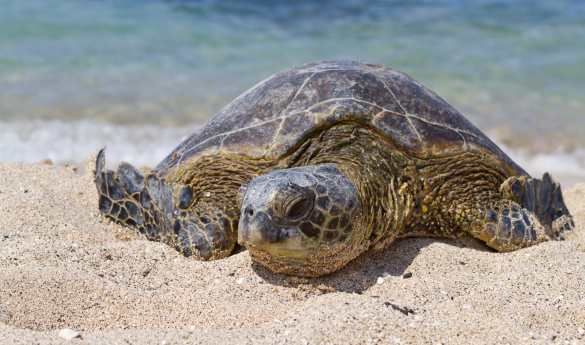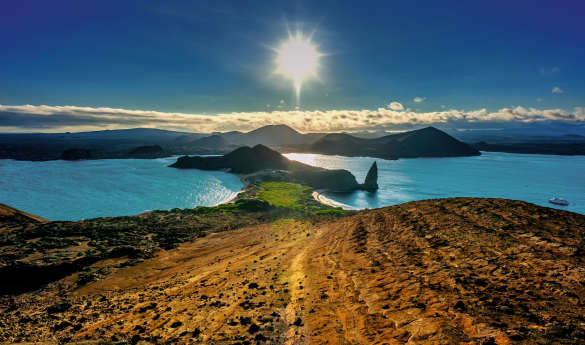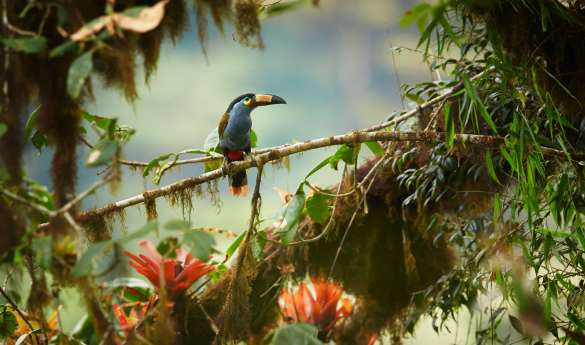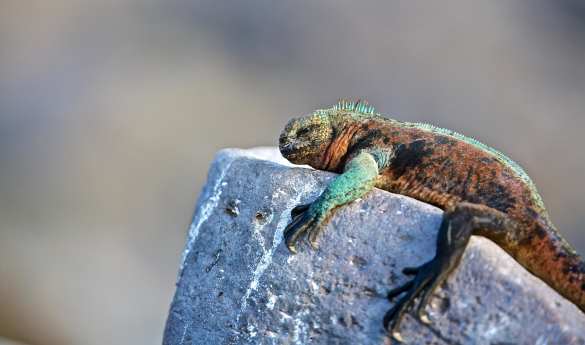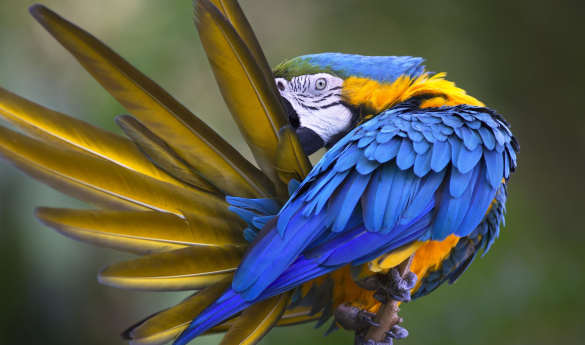A Guide To Visiting the Galapagos
Undoubtedly one of the most spectacular wildlife-watching spots in the world, the Galápagos Islands truly are the destination of dreams…

If you love luxury travel as much as we do, particularly travel that allows you to get up close and personal with wildlife, you’ll have likely heard of the Galapagos Islands. You might, however, have asked yourself, ‘where is the Galapagos?’
The Galapagos islands are part of the country of Ecuador, in South America, sitting within the eastern Pacific Ocean. This chain of islands, otherwise known as an archipelago, lies around 600 miles off the Ecuadorian coast and is situated close to the equator.
How Many Islands Are There in the Galapagos?
There are 13 major islands in the Galapagos, as well as a number of smaller islands that make up the archipelago (roughly 20 in total). The largest island is called Isabela, which is approximately 80 miles long, and 97% of the islands in the Galapagos have been declared a national park thanks to their environmental and biological significance.
The biggest and best islands to stay on while exploring the Galápagos are Isabela, Santa Cruz, San Cristobal and Floreana. Santa Cruz island and its town Puerto Ayora is the most popular place to stay, given the numerous accommodation options and things to do there. The other main islands have limited places to stay, but do offer incredible tours and wildlife experiences, so are still well worth a visit.

How To Get to the Galapagos Islands
Getting to the Galapagos isn’t as tricky as you might think, with daily flights from Europe and the USA into Quito and Guayaquil on mainland Ecuador. From here, it’s a two-hour flight. If you’re wondering how to get to the Galapagos from the UK, you can usually fly to Ecuador from most major city airports; however, there is typically a stopover involved, with the total flight time being around 15 hours. You cannot fly directly to the Galapagos from outside Ecuador. There are two airports on the Galapagos islands themselves, one on Baltra Island (Seymour Airport - GPS), and the other on San Cristobal Island (San Cristobal Airport – SCY).
Most of the domestic flights from Ecuador to the Galapagos depart in the early morning and so an overnight stay the night before departure is required. The most common way to get to and explore the Galapagos is via cruise. Here at Scott Dunn, we can recommend the cruise vessel that best suits you and your needs.

What Is the Best Time of Year to Visit the Galapagos?
The Galapagos is a year-round destination situated close to the equator. The weather here is unpredictable, and as such, peak seasons are only dictated by holiday periods such as the summer holidays, easter or Christmas. The busiest times are June to August and December to January, so advanced planning is recommended. From January to May, the seas are warmer and calmer, making them the best months for cruises if you are susceptible to seasickness. These are also the rainier months, but once it has rained, it usually clears up quickly.
June through November is the dry, cooler season but air temperatures don’t fall much below 20℃, making it a perfectly pleasant time to visit. If you’re planning to snorkel or scuba dive, bear in mind that sea temperatures are lower but most boats will provide shorty wetsuits either free of charge or for a small rental fee. We also recommend packing a rash vest for extra insulation.
What Is the Climate of the Galapagos Islands?
The Galapagos islands have a variable climate - both tropical and arid, with a hot and rainy season from January through May. Despite this, the climate is much cooler than expected given its close proximity to the equator. In general, the weather varies from year to year and can be quite unpredictable - so pack versatile items to keep up with the changing weather.
What to Do in the Galapagos Islands
Famously visited by Charles Darwin, who wrote his theory of evolution based on the animals and environment he encountered here, there’s plenty to do in the glorious Galapagos. It should come as no surprise, though, that much of this is based on exploring the national parks and local wildlife. At Scott Dunn, we offer several luxury tours and cruises around the Galapagos Islands, all of which are tailor-made to you, allowing you to make the most of your visit.
Here are some of our top recommended activities when it comes to things to do in the Galapagos Islands:
Snorkelling - no doubt one of the Galapagos’ key draws, snorkelling here allows you to get up close and personal with the region’s resident marine life. You’ll be treated to a vast array of marine creatures including colourful fish, reef sharks, turtles, manta rays, sea lions and many more. Santa Cruz in particular offers some of the best spots for snorkelling - including Carrion Point and Gordon Rocks.
Hiking - thanks to their national park status, the Galapagos islands are protected which means not every part of the park can be explored. However, there are some stunning set trails marked for visitors which allow you to take in the islands. One of these is the unique lava rock trail in Santa Cruz, where you can expect to see marine iguanas, sea lions, and the Sierra Negra - the second-largest volcano caldera in the world.
Sea kayaking - taking to the waters via a sea kayak is a great way to immerse yourself in the marine world, and you don’t need any previous experience to do it. Explore hidden coves, mangroves and beautiful beaches by kayak - all whilst admiring the marine creatures swimming alongside you! It’s worth noting that you’ll need permission to sea kayak from the National Park, so do be aware of any guidelines before you head out into the water.
Cycling - similar to hiking, you won’t be able to cycle everywhere on the protected islands, but in certain places you will be able to rent mountain bikes to take in the scenery on two wheels. Some islands even offer cycling tours, showing you the best bits.
Diving - diving is another great way to discover the marine world of the Galapagos. Divers have witnessed not only colourful reef fish, but also White-Tip sharks, Golden rays, Hammerheads, and even Whale sharks on their dives, with two of the best spots being Wolf Island and Darwin Island.
But take note, as Marianne Baring, Scott Dunn’s Latin America Destination Expert says:
“You’ll need your diving licence to do this and the PADI open water qualification at a minimum. Diving in the Galapagos is not advisable for anyone who hasn’t done much diving as there are three different ocean currents so you should be experienced and know exactly how to handle yourself when diving.”
Dinghy rides - if you’re not qualified for diving, you can always take to the water in a dinghy, otherwise known as a Panga. These small vessels often serve as a way of getting between the cruise ships to the different islands and visitor spots. It’s also a great chance to photograph some of the wildlife living around the shores.
Visiting the Charles Darwin research station - if you’re interested in the incredible ecosystems of the Galapagos and the history of the islands, you can’t miss a visit to the Charles Darwin research station located on Santa Cruz island. Suitable for both adults and kids, here you can learn all about the various islands and their inhabitants, as well as the conservation work the Charles Darwin Foundation has put in place. You may even get to meet some of the island’s baby Giant tortoises!
Exploring the lava tunnels - one of the Galapagos Islands’ most intriguing natural charms is undoubtedly its lava tunnels located in Santa Cruz. Formed thousands of years ago, these tunnels form an underground network covering roughly 7880 square kilometres of land. The best way to explore these is through an organised tour.
What Animals Are on the Galapagos Islands?
The Galapagos Islands are rich in wildlife, offering plentiful opportunities to immerse yourself in nature and discover all manner of weird and wonderful creatures - so you’ll certainly want to take your camera.
Land-based animals that live on the Galapagos Islands include iguanas, Giant tortoises, Flightless cormorants, penguins, and flamingos. Meanwhile, the oceans surrounding the islands are teeming with a stunning array of marine life, including:
- sea turtles
- Fur seals
- Manta rays
- Dolphins
- Marine iguanas
And countless rare and exotic species of fish, so don’t forget to pack your snorkel!
Latin America Destination Expert Marianne says:
“There is so much you can see whilst on the Galapagos and the experience is just magical. For me, the highlights are seeing the male frigate birds pumping their chests and the Galapagos albatross courtship dance.”

Other Important Things To Know Before Travelling to the Galapagos
Before you head off on your luxury holiday to the Galapagos Islands, here are a few need-to-knows so that you’re prepared ahead of your trip.
Are There Any Restrictions on the Galapagos Islands?
19 islands make up the archipelago, of these, only four are populated and the rest are designated National Parks. Despite concerns over the environment, it should be reassuring to know that tourism is more highly regulated here than anywhere else in the world. Every year, a maximum of 75,000 visitors may enter the national parks. There are in the region of 60 vessels visiting 145 different sites, all on carefully planned itineraries which are monitored by the national park, and timings that generally cannot be changed. Over the last 15 years, it is also reassuring to know that the capacity hasn’t increased on the ships. For visitors staying on a lodge on Santa Cruz island, it is important to know there are just seven boats licensed for day tours with a total capacity of 80 people, so our travel experts will ensure your day trips are planned well in advance of arrival.
Here’s some more information on visas, insurance, and passports:
Visas: Citizens of the United States, Canada, and most European countries, including the UK, do not require a visa to travel to Ecuador or the Galapagos Islands unless they expect to stay for more than 90 days over the course of one year.
Insurance: As of June 2018, Health Insurance has become mandatory for all travellers entering Ecuador. This insurance must be acquired in your country of residency prior to your departure.
Passports: Your passport should have remaining validity of at least six months beyond your travel dates.
Is the Galapagos Suitable for Children?
Each day in the Galapagos offers a new adventure, where children can observe wildlife up close and learn all about evolution and nature without the need for a textbook. It truly is an incredible destination for the whole family. If you’re interested to learn more, read our guide on Galapagos for families.
Can You Swim in the Galapagos?
Yes, the Galapagos Islands are the perfect place to don your snorkel and swim, thanks to the stunning array of marine life that call it home.
The Galapagos Islands are situated in the doldrums, a tropical belt where the prevailing winds are calm, making it safer to swim too. Between December and March, winds are entirely absent, whilst August and September bring the strongest winds and with them, slightly choppy seas. This is less noticeable on larger vessels so if seasickness is a worry, then we would recommend choosing one of the bigger ships during these months and carrying some anti-sickness tablets with you.
How do I organise diving?
The Galapagos is one of the most unique diving destinations in the world and a number of cruise ships, such as the Galapagos Sky, offer diving-specific itineraries which exclusively visit the best marine sites. If you prefer to combine diving with excursions on land, then hotel-based packages offer a bit more flexibility in terms of wildlife viewing and island visits. Your Scott Dunn consultant will advise on the best way to organise diving but be aware that it is safest for experienced divers only.

What Should You Pack for a Galapagos Holiday?
With a changeable climate and an array of activities on offer, it can be tricky to know what to pack for a holiday to the Galapagos - so we’d recommend preparing for all scenarios.
Here are some of the essentials according to Marianne:
“Comfortable walking shoes or boots are a crucial item as you’ll likely be doing a fair amount of walking. I’d also recommend waterproof sandals like those by Teva - essential for wet landings, going out in kayaks or on stand-up paddleboards. Swimsuits are a must as well as rash vests for children, plus lightweight layers like a sweater or fleece for cool evenings, and a rain jacket for the higher altitudes of the Galapagos where it is cool and misty.”
Other items include:
- T-shirts
- Vests
- Shorts/skirt
- Trousers
- Dresses
- Jacket/fleece
- Waterproof coat
Footwear:
- Hiking boots
- Trainers
- Sandals
Accessories:
- Scarf
- Sunglasses
- Rucksack/handbag
- Hat
Electronics and general items
- Phone
- Laptop/tablet
- Camera
- Adaptor plug
- Chargers
- Power bank
- Memory card
- Snorkelling gear/goggles
- Suncream - SPF30+ is recommended (must be reef-safe
- Toiletries
- Medicine bag including insect repellent (DEET-free), painkillers and regular medications
Marianne also highly recommends downloading a stargazing app before you go to make the most of the clear starry skies.
Can You Touch the Animals in the Galapagos?
Despite their curiosity with humans, visitors should NEVER touch the animals and you should really try not to let them touch you. The Galapagos is a fragile ecosystem and infections and diseases can have devastating consequences. Anyone travelling into the park must be accompanied by a naturalist guide, who is on hand to ensure regulations are adhered to and to educate visitors on the unique flora and fauna.
Is There Internet Access in the Galapagos?
If you need to stay connected during your holiday, you can. It is important to know that service on the whole is slow in the Galapagos, with intermittent reception and low bandwidth. Lodges such as Finch Bay and the Galapagos Safari Camp have WiFi but won’t be able to handle large data downloads. Vessels La Pinta and Silver Origin (on varying packages) offer complimentary WiFi. At the moment, smaller vessels do not all have WiFi capability. During visits within the national park (which excludes the populated islands), visitors are required to switch mobile phones to ‘Airplane mode’. Populated areas, like Puerto Ayora on Santa Cruz, do benefit from mobile phone coverage from local providers Movistar or Claro.
What Additional Costs Can You Expect?
While our cruise and lodge packages mostly cover food and soft drinks, you will likely have to pay for alcohol, wetsuit rental on some cruises, tips for guides and staff, and souvenirs. Some of the cruises also have internet packages for purchase. We recommend checking in advance if your cruise can take card payments on board because some of the smaller ships will only accept cash - chat with a Scott Dunn travel expert to find out more.
Visitors to the Galapagos are also required to pay a park fee and purchase a tourist card prior to arrival at the National Park, which is usually included when you book with Scott Dunn. However, it is worth being aware that if you’re not booking a cruise, it may not be possible to pay this in advance.
Marianne says:
“If you really need to be connected whilst travelling in the Galapagos, speak to your Scott Dunn consultant at the time of booking who will facilitate this and make sure you are on the best vessel/accommodation to facilitate communication with the wider world.”
So there you have it, everything you need to know about the Galapagos islands. If you’re interested in booking your adventure of a lifetime, get in touch with one of our friendly travel experts to find out more.
Filter
-
![Galapagos Islands]()
Galapagos Islands
Famous for its unique and fearless wildlife, the Galapagos Islands, just off the coast of Ecuador, are best experienced by cruise. You can swim with sea lions, float eye-to-eye with a penguin, stand next to a blue-footed booby feeding its young, watch a giant tortoise lumbering through a cactus forest and try to dodge the iguanas scurrying over the lava.
Call us on +65 6028 0820 to start planning
